Pilgrimage sites
Grand Bassin
Grand Bassin or Ganga Talao is a sacred lake, which is about 1800 feet above sea level and is situated 2 km to the east of Le Pétrin. The crater lake is one of the most important hindu pilgrimage sites outside of India.
During the week there is an idyllic and calm atmosphere at Grand Bassin, whereas between the end of febuary and the beginning of march crowds of pilgrims are heading to the lake: when Maha-Shivaratree is celebrated, more than 400.000 believers make the pilgrimage to Ganga Talao to make sacrifices to their gods.
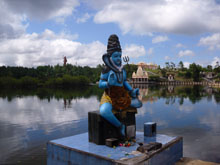
According to a legend the crater lake is connected with the holy river Ganges. The god Shiva, the transformer and destroyer, and his wife Parvati were fyling around the world in a ship. Shiva wanted to show Parvati the most beautyful places on earth, so they stopped in Mauritius. During the journey, Shiva was carrying the river Ganges on his head, to prevent the earth from floodings. When they wanted to land in Mauritius, Shiva accidently spilled water of the holy river. Trops of it were flowing together in the crater – this is how Grand Bassin emerged.
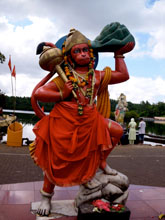
Along Grand Bassin there are several temples dedicated to Shiva and other Gods, little shrines and colourful statues.
Not far from Grand Bassin one can admire an impressive statue of the god Shiva. It is 33 meters tall and is known as the highest statue in Mauritius.
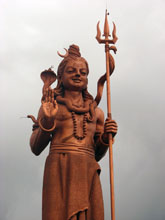
Tourists are welcome to visit the temples and Grand Bassin itself. Nevertheless one should follow a certain code of behaviour: Do not dress inappropriatly (no short skirts, trousers and thirts). To take photographies is allowed, but do not forget to behave respectful. Before entering the temple, please take off your shoes.
Grand Bassin is one of the highlights of a holdiday in Mauritius. If you are interested in foreign cultures and religions, you should not miss out to visit the tempels and the sacred lake!
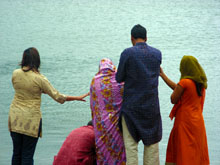
Report: Mahashivratree 2010 in Mauritius
The biggest Hindu festival outside of India is taking place during my stay in Mauritius? I did not want to miss the chance to be on the spot!
 On the 12th of febuary 2010 the final day of Mahashivratree was taking place. During the days of the festival, thousands of believers made the pilgrimage to Grand Bassin! Several times I have read about the important event and I was very excited to see what it is like. For reasons of our laziness we did not walk certainly. So, me and three friends of mine were taking the car to the south. To avoid getting in a traffic jam, we headed off to Grand Bassin around 6 am. Very tired, but impressed by an amazing sunrise, we arrived without any problems. Directly in front of the sight we found a parking, which would not have been possible later on. Due to the fact, that Grand Bassin is located in the highlands of Mauritius, rain is the order of the day. Accordingly the first thing we did was to pack out our rain coats and umbrellas.
On the 12th of febuary 2010 the final day of Mahashivratree was taking place. During the days of the festival, thousands of believers made the pilgrimage to Grand Bassin! Several times I have read about the important event and I was very excited to see what it is like. For reasons of our laziness we did not walk certainly. So, me and three friends of mine were taking the car to the south. To avoid getting in a traffic jam, we headed off to Grand Bassin around 6 am. Very tired, but impressed by an amazing sunrise, we arrived without any problems. Directly in front of the sight we found a parking, which would not have been possible later on. Due to the fact, that Grand Bassin is located in the highlands of Mauritius, rain is the order of the day. Accordingly the first thing we did was to pack out our rain coats and umbrellas. 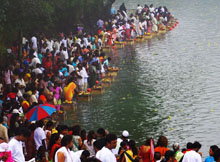 „On Mahashivratree it is always raining” we hear a pilgrim saying. However, in the moment we saw the 33 meter high, bronze Shiva statue we forgot about the beastly weather. In front of the massive statue hindus offered sacrifices, like bananas and coconuts. They lighted joss sticks and prayed to their god. Beside the statue little monkeys came out of the bushes to take advantage of the favourable situation. Some pilgrims could not resist to throw some bananas to the animals. On the edge of the street there were some stalls from various organisations, which gave explanations about meditation, karma and Hinduism. Even Shiva-Merchandise like stickers and t-shirts, with the mantra “Om namah Shivaya” were not missing. A big banner with the label “Discover the Secrets of Lord´s Divine Cuisine” hinted at a big food stand, which distributed food for free for the pilgrims, which were standing in a long queue. The sacred lake is not far away. Around 400 000 Hindus and members
„On Mahashivratree it is always raining” we hear a pilgrim saying. However, in the moment we saw the 33 meter high, bronze Shiva statue we forgot about the beastly weather. In front of the massive statue hindus offered sacrifices, like bananas and coconuts. They lighted joss sticks and prayed to their god. Beside the statue little monkeys came out of the bushes to take advantage of the favourable situation. Some pilgrims could not resist to throw some bananas to the animals. On the edge of the street there were some stalls from various organisations, which gave explanations about meditation, karma and Hinduism. Even Shiva-Merchandise like stickers and t-shirts, with the mantra “Om namah Shivaya” were not missing. A big banner with the label “Discover the Secrets of Lord´s Divine Cuisine” hinted at a big food stand, which distributed food for free for the pilgrims, which were standing in a long queue. The sacred lake is not far away. Around 400 000 Hindus and members 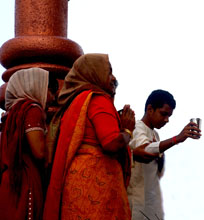 of other religions have been walking the last days and nights to Grand Bassin. The lake was spilled over, because of all the rain and the uncountable pilgrims were ankle-deep in water. The believers put down flowers and fruits and the air was filled with the scent of joss sticks. In the main tempels and in front of the statues of the gods Ganesha, Ganga and Hanuman there were masses of people, who were waiting to offer their sacrifices. The Hindus do not mind the curious tourists, who are observing the ceremonies. No matter which pilgrim we were asking questions about the festival, we always got an friendly and detailed answer. In this way we came to know, that there is a very special atmosphere on the last day of Mahashivratree. From dusk until late at night the believers dedicate special prayers to Lord Shiva. In this night they are able to become connected with the moon and accordingly the god Shiva. The moon has an important meaning in Hinduism. Like the human psyche, the moon has sixteen phases. Due to the decreasing moon fifteen phases are already overcome. The sixteenth phase vanishes
of other religions have been walking the last days and nights to Grand Bassin. The lake was spilled over, because of all the rain and the uncountable pilgrims were ankle-deep in water. The believers put down flowers and fruits and the air was filled with the scent of joss sticks. In the main tempels and in front of the statues of the gods Ganesha, Ganga and Hanuman there were masses of people, who were waiting to offer their sacrifices. The Hindus do not mind the curious tourists, who are observing the ceremonies. No matter which pilgrim we were asking questions about the festival, we always got an friendly and detailed answer. In this way we came to know, that there is a very special atmosphere on the last day of Mahashivratree. From dusk until late at night the believers dedicate special prayers to Lord Shiva. In this night they are able to become connected with the moon and accordingly the god Shiva. The moon has an important meaning in Hinduism. Like the human psyche, the moon has sixteen phases. Due to the decreasing moon fifteen phases are already overcome. The sixteenth phase vanishes 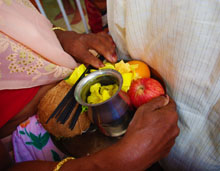 through ceremonies and rituals. In this way the mind is freed and unified with the divine. One of the most important rituals is the fasting before the pilgrimage. Furthermore the believers scoop water out of Grand Bassin and pour it over Shiva statues in compliment to the god. Another important ritual is the watering of the Shiva Lingam, a symbol for Lord Shiva. Additionaly leaves of the holy beal tree are being strew about the Lingam. The observation of the different ceremonies and the atmosphere at Grand Bassin was an unique experience. After all the rain there was brilliant sunshine at noon. More and more people flocked to the sakred lake. After having all these unforgettable impressions we were taking our way back home. We were very happy to be able to see Mahashivratree, but next time we make the pilgrimage by foot 🙂
through ceremonies and rituals. In this way the mind is freed and unified with the divine. One of the most important rituals is the fasting before the pilgrimage. Furthermore the believers scoop water out of Grand Bassin and pour it over Shiva statues in compliment to the god. Another important ritual is the watering of the Shiva Lingam, a symbol for Lord Shiva. Additionaly leaves of the holy beal tree are being strew about the Lingam. The observation of the different ceremonies and the atmosphere at Grand Bassin was an unique experience. After all the rain there was brilliant sunshine at noon. More and more people flocked to the sakred lake. After having all these unforgettable impressions we were taking our way back home. We were very happy to be able to see Mahashivratree, but next time we make the pilgrimage by foot 🙂
